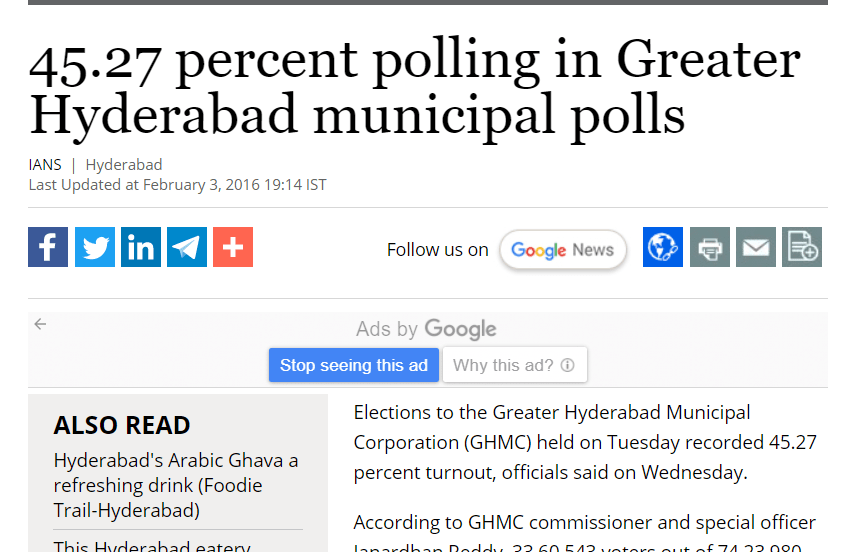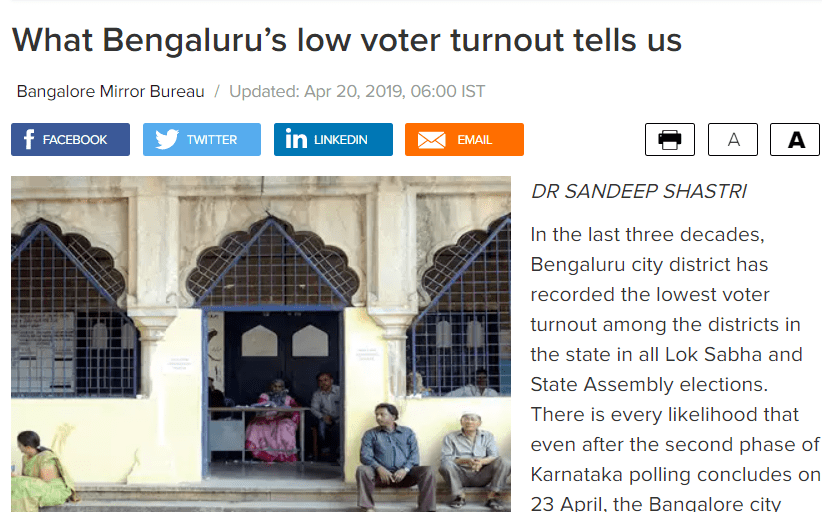The perception about the urban voter is that of an aware individual involved in the political process. Citizen activism campaigns on protecting green cover, conserving lakes to influence local bodies have shown their involvement in politics at the local level. This involvement in politics, however, does not translate into exercising their political franchise.
Voter turnout percentages in various municipal corporations across the country has been dismal. The Greater Hyderabad Municipal Corporation (GHMC) elections saw a voter turnout[1] of 45.27 percent. A study titled “Municipal Corporation Elections in Maharashtra: A Data Analysis” (1994-2004)[2] concluded that the average voter turnout during Brihanmumbai Municipal Corporation (BMC) polls was around 45 percent.

Other metropolitan cities like Bengaluru, Pune, Chennai, Kolkata reflect the trend. A common cause that is cited for the low turnouts is the apathy and cynicism towards the voting process.
Apathy though is not the cause, merely a symptom. The causes for the apathy vary with different socio-economic groups. But one common thread that connects all the strata of society is the ‘social capital’.
Social capital is the network of relationships between people living in a society. Low turnouts signal a non-participation of people in the democracy. It is a barometer of measuring the social capital. When the interdependency between the people and the governance system is fragile, the citizen engagement is at a minimum.

Source: Medium
The engagement of citizens is low when the ‘Political Interest Index’[3] is low. The segments of population who have vested interests in the local governance system are more likely to vote. As they are the beneficiaries of the local laws and schemes. The poor, elderly, married couples mostly fall in this segment.
Assuming all these people vote gives a skewed understanding. Their social status in society plays a role in determining who votes. The highly educated, young and female population who are politically disinterested do not vote. They perceive their social capital to be diminished as local governance does not affect them.
Bangalore Mirror[4] discusses the reasons of apathy. Names of eligible voters go missing from the electoral rolls. This indifference shown by the system begets indifference of the public. It tells them they do not matter. They believe their participation does not change the political landscape.

Source: Bangalore Mirror
As a result, proportionally misrepresented bodies get elected due to skewed voting patterns. This deficit of trust needs to be bridged by building social capital to bring these voters to the booths on voting day.
[1] Business Standard – Feb 2016: 45.27 percent polling in Greater Hyderabad Municipal polls
[2] WHY-PEOPLE-DO-NOT-VOTE-IN-MUNICIPAL-CORPORATION-ELECTIONS-A-VOTER-BASED-SURVEY-IN-MUMBAI-MUNICIPAL-CORPORATION.pdf, GIPE
[3] WHY-PEOPLE-DO-NOT-VOTE-IN-MUNICIPAL-CORPORATION-ELECTIONS-A-VOTER-BASED-SURVEY-IN-MUMBAI-MUNICIPAL-CORPORATION.pdf, GIPE
[4] What Bengaluru’s low voter turnout tells us

This is a very interesting post. I have spent quite a bit of my career within local government, conducting training of both elected members and officers and consulting to it as well.
The urban experience where I am is for Western Australia. Elections are tightly monitored. So, for the Perth metropolitan region, the voter turnout is generally 30%. However, in regional urban areas it is significantly higher (35% – 50%). Further still, in the rural areas, voter turnout is traditionally in the order of 35% – 75%, with an average of around 60% (at times it will peak well over 80%).
Much of what you set out here re social capital and the voting franchise is just as applicable where I am. The biggest difference is that in rural areas, if there is a burning issue, then voter turnout rates will be up across the board. However, in the metropolitan area, regardless of the issues, it remains, on average around 30%, election after election.
LikeLiked by 1 person
I agree. The voting patterns as we move away from the metropolitan cities to the hinterland stack up the the same way.
I guess urbanisation and capitalist market economy in the metropolitan cities have made the basic civic amenities to people without being dependent solely on the government. The rural areas need more government intervention to provide to the local communities, so voting matters so that they bring in governments that meet their requirements.
LikeLiked by 1 person